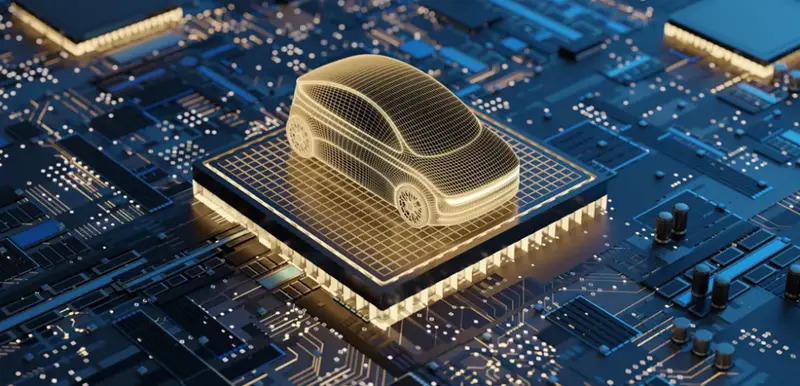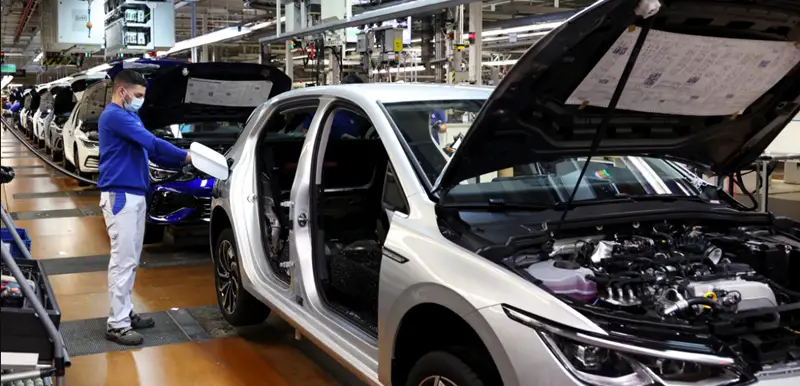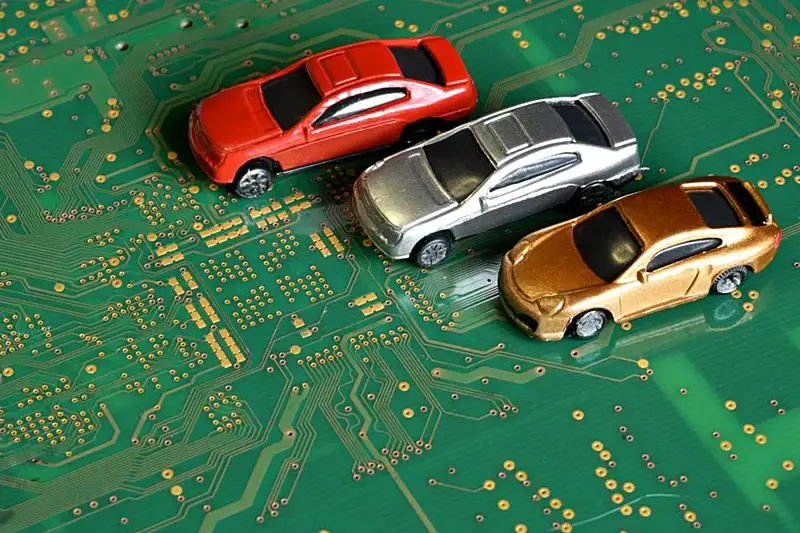Wait, what? You’re telling me a tiny piece of silicon smaller than my fingernail can determine whether I can buy that shiny new car I’ve been eyeing? Welcome to the wild world of the car chip shortage – a crisis that’s turned the automotive industry upside down and made car buying feel like trying to catch lightning in a bottle.
The semiconductor shortage has fundamentally transformed how we think about vehicle manufacturing, supply chain management, and consumer purchasing decisions. This isn’t just another business disruption – it’s a complete reshaping of the automotive landscape that affects everyone from Detroit automakers to everyday car buyers in Mexico City.
Also read: The Evolution of Automotive Design
Table of Contents

Understanding the Automotive Semiconductor Crisis
Let’s get one thing straight – when we talk about the car chip shortage, we’re not discussing potato chips (though I could go for some right about now). We’re talking about semiconductor microchips, those microscopic marvels that power everything from your car’s engine management system to its infotainment display.
The industry has regained its manufacturing pace, but potential disruptions in chip supply remain, according to recent industry analysis. But here’s the kicker – modern vehicles contain anywhere from 1,500 to 3,000 semiconductors! That’s more computing power than what sent astronauts to the moon, and it’s exactly why the car chip shortage has had such a massive impact on vehicle production.
The global car chip shortage began during the COVID-19 pandemic when automotive production halted while consumer electronics demand skyrocketed. Semiconductor manufacturers pivoted their production lines to serve tech companies, leaving automakers scrambling for supply when they resumed operations.
The Perfect Storm: How Supply Chain Disruptions Created Chaos
Picture this: It’s early 2020, and automakers are canceling chip orders left and right as lockdowns shut down production facilities. Meanwhile, everyone’s stuck at home buying laptops, gaming consoles, and smartphones like there’s no tomorrow. Semiconductor foundries, being the savvy businesses they are, redirected their manufacturing capacity to serve these high-demand electronics markets.
When automotive production resumed, guess what happened? The chip manufacturers had already committed their production capacity elsewhere. More than 11 million vehicles had to be removed from production in 2021 due to the car chip shortage, creating a domino effect that we’re still feeling today.

Current State of Vehicle Production and Manufacturing Challenges
Here’s where things get really interesting (and frustrating if you’re trying to buy a car). The automotive industry is experiencing what experts call a “bullwhip effect” – the growing car chip shortage is prompting automakers to order surplus semiconductors—about 10 to 20 percent more than needed—to ensure inventory and safeguard production.
But wait, there’s more! Different types of semiconductors require different manufacturing processes. The automotive industry relies heavily on mature node chips (40 nanometers and above), which are exactly the type that remain in short supply. These aren’t the cutting-edge processors in your smartphone – they’re the workhorses that control everything from airbag deployment to anti-lock braking systems. The car chip shortage has spotlighted how dependent modern vehicle production is on these legacy components.
Production Line Bottlenecks and Assembly Plant Shutdowns
Car manufacturers have had to make some tough choices. Some have prioritized production of their highest-margin vehicles, while others have built cars without certain features, planning to retrofit them later when chips become available. Ford, General Motors, and Toyota have all experienced temporary plant shutdowns due to the car chip shortage.
The ripple effects extend beyond just vehicle assembly. Tier-1 suppliers – the companies that make components for automakers – have struggled to maintain their own production schedules, creating a cascading effect throughout the entire automotive supply chain.

Impact on Car Prices and Consumer Purchasing Power
Now let’s talk about what really matters to you as a consumer – your wallet. The car chip shortage has created a perfect storm of reduced inventory, increased demand, and skyrocketing prices. Global car sales in 2021 were down by more than 12 percent compared to 2019, resulting in a loss of ~$210 million USD in revenue for the global automotive industry.
But here’s the twist – while the industry lost revenue due to reduced sales volume, individual car prices went through the roof. Limited inventory means dealerships can charge premium prices, and consumers have little choice but to pay up or wait indefinitely. The car chip shortage has reshaped buyer behavior and pushed many consumers to act fast or get left behind.
New vs Used Car Market Dynamics
The used car market has gone absolutely bonkers. With fewer new cars available due to the ongoing car chip shortage, demand for pre-owned vehicles has intensified dramatically. Cars that typically depreciate the moment you drive them off the lot have been holding their value or even appreciating in some cases. It’s like the automotive equivalent of the housing market during the pandemic!
This has created a unique situation where trading in your current vehicle might actually net you more money than you paid for it originally. Wild times, right?
Visual Data: Understanding the Scope of Impact
Car Production Decline Chart (2019-2024)
2019: ████████████████████████ 95M vehicles
2020: ██████████████████ 77M vehicles (COVID impact)
2021: ████████████████ 80M vehicles (Chip shortage begins)
2022: ██████████████████ 85M vehicles (Partial recovery)
2023: ████████████████████ 90M vehicles (Continued recovery)
2024: ██████████████████████ 93M vehicles (Near normal)Semiconductor Content by Vehicle Type
Traditional ICE Vehicle: ████ ~1,500 chips
Hybrid Vehicle: ████████ ~2,100 chips
Electric Vehicle: ████████████ ~3,000 chips
Autonomous Vehicle: ████████████████ ~4,000+ chipsRegional Production Impact (2021 Peak Shortage)
North America: ████████ 30% production cuts
Europe: ██████ 25% production cuts
Asia: ████ 15% production cutsRegional Manufacturing Responses and Recovery Strategies
Different regions have responded to the car chip shortage in fascinating ways. TSMC announced it would triple its investment in its Arizona plants to a total of $40 billion. The start of chip production at the first factory has been pushed back to 2025, showing how seriously the industry is taking supply chain resilience.
European automakers have focused on building stronger relationships with semiconductor suppliers and implementing more flexible manufacturing processes. Meanwhile, Asian manufacturers, being closer to major chip production facilities, have had slightly better access to semiconductors but still face significant challenges.
Government Interventions and Policy Responses
Governments worldwide have recognized the strategic importance of semiconductor manufacturing. The United States has passed legislation to incentivize domestic chip production, while the European Union has launched its own semiconductor strategy. The US government offered various forms of support to mitigate the car chip shortage and build long-term resilience.
These aren’t just short-term fixes – they represent a fundamental shift toward viewing semiconductor manufacturing as a national security issue rather than just an economic one.
Electric Vehicle Production and Next-Generation Technology
Here’s where things get even more complex. Electric vehicles require significantly more semiconductors than traditional internal combustion engine vehicles. We’re talking about battery management systems, advanced driver assistance systems, over-the-air update capabilities, and sophisticated infotainment systems. These demands make EVs especially vulnerable during the car chip shortage.
The transition to electric vehicles is happening simultaneously with the semiconductor shortage, creating a double challenge for automakers. They need to secure chips for current production while also preparing for the exponentially higher semiconductor requirements of their electric vehicle lineups—further intensifying the impact of the car chip shortage.
Advanced Driver Systems and Connected Car Features
Modern cars are essentially smartphones on wheels, packed with connectivity features, advanced safety systems, and autonomous driving capabilities. Each of these systems requires dedicated semiconductors, and the complexity continues to grow with each model year. The car chip shortage has forced automakers to make difficult decisions about which features to include in new vehicles. Some have shipped cars without certain connected features, promising to add them later through software updates once the necessary chips become available.
Future Outlook: Timeline for Automotive Industry Recovery
So when will this madness end? The answer is… complicated. Key companies in the automotive and semiconductor industries have expressed concerns about a potential semiconductor shortage in the second half of 2025 or 2026. Just when you thought we were getting back to normal!
The reality is that semiconductor demand continues to grow across all industries, while manufacturing capacity takes years to build. Some researchers project the global supply of legacy chips won’t catch up with projected demand until 2025. The car chip shortage remains a moving target with no guaranteed resolution in sight.
Long-term Supply Chain Transformation
The automotive industry is fundamentally rethinking its approach to supply chain management. The traditional just-in-time manufacturing model, which minimizes inventory costs, has proven vulnerable to disruptions. Many automakers are now building strategic inventory buffers and diversifying their supplier base.
This transformation will likely result in slightly higher vehicle costs in the long term, but it should also provide better resilience against future disruptions like the car chip shortage.
Practical Buying Advice for Today’s Car Market
Alright, let’s get practical. If you need a car right now, what should you do? First, be prepared for limited inventory and higher prices. The days of walking into a dealership and negotiating significant discounts are largely over, at least for now.
Consider expanding your search beyond your preferred make and model. Some manufacturers have been less affected by the car chip shortage than others, and you might find better availability and pricing with brands you hadn’t previously considered.
Timing Your Purchase in the Current Market
If you can wait, should you? It depends on your situation. If your current vehicle is reliable and meets your needs, waiting might make sense. However, if you need a car for work or family obligations, don’t gamble on future price improvements that might not materialize—especially as the car chip shortage continues to disrupt supply chains.
The used car market might offer better immediate availability, but prices are elevated there too. Consider certified pre-owned programs, which can provide additional peace of mind when buying a used vehicle during the car chip shortage, when both new and used inventories are strained.
Myths vs Reality: Debunking Car Chip Shortage Misconceptions
Myth: The chip shortage only affects luxury vehicles
Reality: The car chip shortage impacts vehicles across all price segments. While luxury cars might have more advanced features requiring semiconductors, even basic economy cars need chips for essential safety and engine management systems.
Myth: Automakers could easily switch to different chip suppliers
Reality: Automotive semiconductors are highly specialized and must meet strict safety and reliability standards. The car chip shortage has revealed how difficult it is to pivot to alternative suppliers. Switching requires extensive testing and certification, which can take 12–18 months or longer.
Myth: The shortage will end suddenly when new factories come online
Reality: Semiconductor demand continues growing across all industries. Even as new capacity becomes available, it may be absorbed by expanding demand rather than eliminating shortages entirely. This means the car chip shortage is likely to persist in some form for years.
Myth: Buying used cars is always cheaper during the shortage
Reality: Used car prices have also increased dramatically due to limited new car availability caused by the car chip shortage. In some cases, used vehicles are selling for close to their original MSRP or even higher.
Myth: Only high-tech features are affected by chip shortages
Reality: Even basic functions like power windows, seat adjustments, and engine control units require semiconductors. The car chip shortage can impact virtually any electronic system in a modern vehicle, regardless of its price or complexity.
Frequently Asked Questions About the Car Chip Shortage
Q: Why do modern cars need so many semiconductors?
A: Today’s vehicles are essentially computers on wheels. Semiconductors control everything from engine management and safety systems to infotainment and connectivity features. A typical car contains 1,500-3,000 chips handling functions like airbag deployment, anti-lock brakes, fuel injection, climate control, and navigation systems. This heavy reliance on chips is exactly why the car chip shortage has had such a widespread impact.
Q: Which car brands have been most affected by the chip shortage?
A: The impact of the car chip shortage has been widespread, but some manufacturers have been hit harder than others. General Motors, Ford, and Stellantis (formerly Chrysler) experienced significant production cuts. Toyota initially weathered the crisis better due to its larger inventory buffers, but eventually faced challenges too.
Q: Are car prices expected to return to pre-shortage levels?
A: Unfortunately, probably not entirely. While prices may stabilize or decrease slightly as supply improves, the industry has learned that consumers are willing to pay higher prices when inventory is limited. The car chip shortage has also pushed automakers to rethink their production models and inventory strategies, leading to lasting pricing changes.
Q: Should I buy a car now or wait for prices to drop?
A: It depends on your personal situation. If you need reliable transportation and can afford current prices, don’t wait for a market correction that might not come. If your current vehicle is reliable and you can wait, monitoring the market for 6-12 months might be worthwhile—especially as the effects of the car chip shortage gradually ease.
Q: How long will the semiconductor shortage continue?
A: Industry experts predict potential shortages could continue into 2025 or 2026, particularly for mature node chips used in automotive applications. However, the severity should decrease as new manufacturing capacity comes online, slowly relieving the car chip shortage.
Q: Are electric vehicles more affected by the chip shortage?
A: Yes, electric vehicles typically require 2-3 times more semiconductors than traditional vehicles due to their battery management systems, advanced driver assistance features, and connectivity requirements. This makes them particularly vulnerable to disruptions like the car chip shortage.
My Final Thoughts on Navigating the Car Chip Shortage
After researching and writing about this topic extensively, I’ve come to realize that the car chip shortage represents more than just a temporary supply chain hiccup. It’s a fundamental wake-up call for an industry that had become perhaps too comfortable with lean manufacturing and global supply chains.
As someone who’s watched this crisis unfold over the past few years, I’m struck by how a component most people never think about has such profound impacts on our daily lives. The next time you start your car, remember that dozens of semiconductors are working together to make that simple action possible.
I believe we’re witnessing a permanent transformation in how the automotive industry operates. The companies that adapt quickly to this new reality – building more resilient supply chains, forming strategic partnerships with semiconductor manufacturers, and designing vehicles with supply chain constraints in mind – will emerge stronger.
For consumers, my advice is to remain flexible and informed. The car market of 2025 looks very different from 2019, and the market of 2030 will likely be different still. The most successful car buyers will be those who adapt their expectations and strategies to match this evolving landscape.
The car chip shortage has taught us all a valuable lesson about the interconnectedness of our modern world. A pandemic in one region, a factory fire in another, or a trade dispute between countries can ripple through global supply chains in ways we never anticipated. As we move forward, resilience will be just as important as efficiency.
Need a mechanic? Find one on the Mobile Mechanic Directory
Downloadable Resource: Car Buying Checklist During Chip Shortages
Pre-Purchase Planning
- Research which models have better availability
- Identify essential vs. nice-to-have features
- Set realistic budget expectations (15-25% above pre-shortage prices)
- Consider expanding brand preferences
- Check certified pre-owned options
During Shopping
- Contact multiple dealerships for availability
- Ask about expected delivery timeframes
- Inquire about feature deletions or substitutions
- Verify warranty coverage for retrofitted features
- Document any promised future feature additions
Financial Considerations
- Get pre-approved financing from multiple sources
- Factor in higher insurance costs for newer/more expensive vehicles
- Consider gap insurance for higher-priced vehicles
- Evaluate trade-in value of current vehicle
- Budget for extended wait times if ordering
Alternative Strategies
- Research lease options vs. purchase
- Consider vehicle subscription services
- Explore car-sharing programs for temporary needs
- Investigate rental car extended programs
- Look into certified pre-owned warranties





